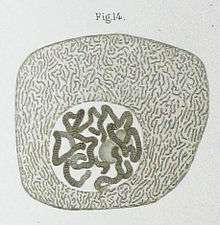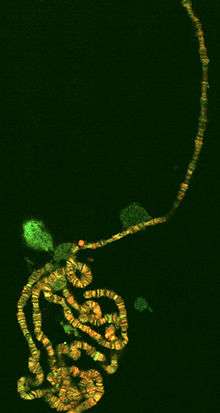Polytene chromosome
Polytene chromosomes are large chromosomes which have thousands of DNA strands. They provide a high level of function in certain tissues such as salivary glands of insects [1]


Polytene chromosomes were first reported by E.G.Balbiani in 1881. Polytene chromosomes are found in dipteran flies: the best understood are those of Drosophila, Chironomus and Rhynchosciara. They are present in another group of arthropods of the class Collembola, a protozoan group Ciliophora, mammalian trophoblasts and antipodal, and suspensor cells in plants.[2] In insects, they are commonly found in the salivary glands when the cells are not dividing.
They are produced when repeated rounds of DNA replication without cell division forms a giant chromosome. Thus polytene chromosomes form when multiple rounds of replication produce many sister chromatids which stay fused together.
Polytene chromosomes, at interphase, are seen to have distinct thick and thin banding patterns. These patterns were originally used to help map chromosomes, identify small chromosome mutations, and in taxonomic identification. They are now used to study the function of genes in transcription.[3]
Function
In addition to increasing the volume of the cells' nuclei and causing cell expansion, polytene cells may also have a metabolic advantage as multiple copies of genes permits a high level of gene expression. In Drosophila melanogaster, for example, the chromosomes of the larval salivary glands undergo many rounds of endoreduplication to produce large quantities of adhesive mucoprotein (“glue”) before pupation. Another example within the fly itself is the tandem duplication of various polytene bands located near the centromere of the X chromosome which results in the Bar phenotype of kidney-shaped eyes.[4][5]
The interbands are involved in the interaction with the active chromatin proteins, nucleosome remodeling, and origin recognition complexes. Their primary functions are: to act as binding sites for RNA pol II, to initiate replication and, to start nucleosome remodeling of short fragments of DNA.[6]
Structure
In insects, polytene chromosomes are commonly found in the salivary glands; they are also referred to as "salivary gland chromosomes". The large size of the chromosome is due to the presence of many longitudinal strands called chromonemata; hence the name polytene (many stranded). They are about 0.5 mm in length and 20 μm in diameter. The chromosomal strands are formed after repeated division of the chromosome in the absence of cytoplasmic division. This type of division is called endomitosis. The polytene chromosome contains two types of bands, dark bands and interbands. The dark bands are darkly stained and the inter bands are lightly stained with nuclear stains. The dark bands contain more DNA and less RNA. The interbands contain more RNA and less DNA. The amount of DNA in interbands ranges from 0.8 - 25%.[2]
The bands of polytene chromosomes become enlarged at certain times to form swellings called puffs. The formation of puffs is called puffing. In the regions of puffs, the chromonemata uncoil and open out to form many loops. The puffing is caused by the uncoiling of individual chromomeres in a band. The puffs indicate the site of active genes where mRNA synthesis takes place.[7] The chromonemata of puffs give out a series of many loops laterally. As these loops appear as rings, they are called Balbiani rings after the name of the researcher who discovered them. They are formed of DNA, RNA and a few proteins. As they are the site of transcription, transcription mechanisms such as RNA polymerase and ribonucleoproteins are present.
In protozoans, there is no transcription, since the puff consists only of DNA.[2]
History
Polytene chromosomes were originally observed in the larval salivary glands of Chironomus midges by Édouard-Gérard Balbiani in 1881.[8] Balbiani described the chromosomal puffs among the tangled thread inside the nucleus, and named it "permanent spireme". In 1890, he observed similar spireme in a ciliated protozoan Loxophyllum meleagris.[1] The existence of such spireme in Drosophila melanogaster was reported by Bulgarian geneticist Dontcho Kostoff in 1930. Kostoff predicted that the discs (bands) which he observed were "the actual packets in which inherited characters are passed from generation to generation."[9]
The hereditary nature of these structures was not confirmed until they were studied in Drosophila melanogaster in the early 1930s by German biologists Emil Heitz and Hans Bauer. In 1930, Heitz studied different species of Drosophila (D. melanogaster, D. simulans, D. hydei, and D. virilis) and found that all their interphase chromatins in certain cells were swollen and messy. In 1932, he collaborated with Karl Heinrich Bauer with whom he discovered that the tangled chromosomes having distinct bands are unique to the cells of the salivary glands, midgut, Malphigian tubules, and brain of the flies Bibio hurtulunus and Drosophila funebris. The two papers were published in the early 1933.[10] Unaware of these papers, an American geneticist Theophilus Shickel Painter reported in December 1933 the existence of giant chromosome in D. melanogaster (followed by a series of papers the following year).[11][12] Learning of this, Heitz accused Painter of deliberately ignoring their original publication to claim priority of discovery.[13] In 1935, Hermann J. Muller and A.A. Prokofyeva established that the individual band or part of a band corresponds with a gene in Drosophila.[14] The same year, P.C. Koller hesitantly introduced the name "polytene" to describe the giant chromosome, writing:
It seems that we can regard these chromosomes as corresponding with paired pachytene chromosomes at meiosis in which the intercalary parts between chromomeres have been stretched and separated into smaller units, and in which, instead of two threads lying side by side, we have 16 or even more. Hence they are "polytene" rather than pachytene; I do not, however, propose to use this term; I shall refer to them as "multiple threads."[15]
Occurrence
Polytene chromosomes are present in secretory tissues of dipteran insects such as the Malpighian tubules of Sciara and also in protists, plants, mammals, or in cells from other insects. Some of the largest polytene chromosomes described thus far occur in larval salivary gland cells of the chironomid genus Axarus.
In plants, they are found in only a few species, and are restricted to ovary and immature seed tissues such as in Phaseolus coccineus and P. vulgaris (Nagl, 1981), and the anther tapetum of Vigna unguiculata and of some Phaseolus species.[16]
Polytene chromosomes are also used to identify the species of chironomid larvae that are notoriously difficult to identify. Each morphologically distinct group of larvae consists of a number of morphologically identical (sibling) species that can only be identified by rearing adult males or by cytogenetic analysis of the polytene chromosomes of the larvae. Karyotypes are used to confirm the presence of specific species and to study genetic diversity in species with a wide range of genetic variation.[17][18]
References
- Zhimulev, Igor F; Koryakov, Dmitry E (2009). "Polytene Chromosomes". Encyclopedia of Life Sciences (eLS). Chichester (UK): John Wiley & Sons, Inc. pp. 1–10. doi:10.1002/9780470015902.a0001183.pub2. ISBN 978-0470016176.
- Sumner, Adrian T. (2002). Chromosomes Organization and Function. Chichester: John Wiley & Sons. pp. 182–193. ISBN 9780470695227.
- Alanen, M. (1986). "Whole mount electron microscopic maps of Drosophila melanogaster polytene chromosomes". Hereditas. 104 (1): 91–101. doi:10.1111/j.1601-5223.1986.tb00521.x.
- Hartwell, Leland; Leroy Hood; Michael L. Goldberg; Ann E. Reynolds; Lee M. Silver (2011). Genetics:From Genes to Genomes; Fourth Edition. New York, NY: McGraw-Hill. ISBN 978-0-07-352526-6.
- Zykova, Tatyana Yu; Levitsky, Victor G.; Belyaeva, Elena S.; Zhimulev, Igor F. (April 2018). "Polytene Chromosomes – A Portrait of Functional Organization of the Drosophila Genome". Current Genomics. 19 (3): 179–191. doi:10.2174/1389202918666171016123830. ISSN 1389-2029. PMC 5850506. PMID 29606905.
- Zhimulev, Igor F.; Belyaeva, Elena S.; Vatolina, Tatiana Yu; Demakov, Sergey A. (2012). "Banding patterns in Drosophila melanogaster polytene chromosomes correlate with DNA-binding protein occupancy". BioEssays. 34 (6): 498–508. doi:10.1002/bies.201100142. PMID 22419120.
- Zhimulev, IF; Belyaeva, ES; Semeshin, VF; Koryakov, DE; Demakov, SA; Demakova, OV; Pokholkova, GV; Andreyeva, EN (2004). Polytene chromosomes: 70 years of genetic research. International Review of Cytology. 241. pp. 203–275. doi:10.1016/S0074-7696(04)41004-3. ISBN 9780123646453. PMID 15548421.
- Balbiani EG (1881). "Sur la structure du noyau des cellules salivaires chez les larves de Chironomus". Zool. Anz. 4: 637–641.
- Kostoff, Dontcho (1930). "Discoid Structure of the Spireme". Journal of Heredity. 21 (7): 323–324. doi:10.1093/oxfordjournals.jhered.a103356.
- D'Angelo, E.G. (1946). "Micrurgical studies on Chironomus salivary gland chromosomes". The Biological Bulletin. 90 (1): 71–87. doi:10.2307/1538062. JSTOR 1538062.
- Falk, R. (2004). "Applying and extending the notion of genetic linkage: the first fifty years". In Gaudillière, Jean-Paul; Rheinberger, Hans-Jörg (eds.). Classical Genetic Research and Its Legacy: The Mapping Cultures of Twentieth-Century Genetics. Oxon: Routledge. p. 52. ISBN 978-0-203-37529-7.
- Painter, T. S. (1933-12-22). "A New Method for the Study of Chromosome Rearrangements and the Plotting of Chromosome Maps". Science. 78 (2034): 585–586. doi:10.1126/science.78.2034.585. ISSN 0036-8075. PMID 17801695.
- Zacharias, H (1995). "Emil Heitz (1892-1965): chloroplasts, heterochromatin, and polytene chromosomes". Genetics. 141 (1): 7–14. PMC 1206741. PMID 8536991.
- Muller, HJ; Prokofyeva, AA (1935). "The Individual Gene in Relation to the Chromomere and the Chromosome". Proceedings of the National Academy of Sciences of the United States of America. 21 (1): 16–26. doi:10.1073/pnas.21.1.16. PMC 1076520. PMID 16577650.
- Koller, P. C. (1935). "The Internal Mechanics of the Chromosomes. IV.—Pairing and Coiling in Salivary Gland Nuclei of Drosophila". Proceedings of the Royal Society B: Biological Sciences. 118 (810): 371–397. doi:10.1098/rspb.1935.0062.
- Carvalheira, Gianna Maria Griz (2000). "Plant polytene chromosomes". Genetics and Molecular Biology. 23 (4): 1043–1050. doi:10.1590/S1415-47572000000400050.
- Int Panis L, Kiknadze I, Bervoets L, Aimanova A (1994). "Karyological identification of some species of the genus Chironomus Meigen, 1803 from Belgium". Bull. Ann. Soc. R. Ent. Belg. 130: 135–142.
- Кикнадзе ИИ; Михайлова П; Истомина АГ; Голыгина ВВ; Инт Панис Л; Крастанов Б (2006). "Хромосомный полиморфизм и дивергенция популяций у Chironomus nuditarsis Keyl (Diptera, Chironomidae)". Tsitologia. 48: 595–609.
Further reading
- Baudisch W (1977). "Balbiani ring pattern and biochemical activities in the salivary gland of Acricotopus lucidus (Chironomidae)". Results Probl Cell Differ. Results and Problems in Cell Differentiation. 8: 197–212. doi:10.1007/978-3-540-37332-2_4. ISBN 978-3-662-21670-5. PMID 335467.
- Bridges CB (1935). "Salivary chromosome maps with a key to the banding of the chromosomes of Drosophila melanogaster". Journal of Heredity. 26: 60–64. doi:10.1093/oxfordjournals.jhered.a104022.
- Daneholt B (1992). "The transcribed template and the transcription loop in Balbiani rings". Cell Biol Int Rep. 16 (8): 709–715. doi:10.1016/S0309-1651(05)80015-3. PMID 1446347.
- Werle SF, E Klekowski & DG Smith (2004). "Inversion polymorphism in a Connecticut River Axarus species (Diptera: Chironomidae): biometric effects of a triple inversion heterozygote". Can. J. Zool. 82: 118–129. doi:10.1139/z03-227.
- Pavan, C. and Breuer, M. E. (1952). "Polytene chromosomes in different tissues of Rhynchosciara". Journal of Heredity. 63: 151–157. doi:10.1093/oxfordjournals.jhered.a106291.CS1 maint: uses authors parameter (link)
- Pavan, C. (1967). "Chromosomal changes induced by infective agents Triangle". Sandoz J. Med. Sci. 8 (2): 42–48. PMID 5602878.
- Pavan, C., Biesele, J., Riess, R. W. and Wertz, A. V. (1971). "XIII. Changes in the ultrastructure of Rhynchosciara cells infected by Microsporidia". Studies in Genetics. VI: 7103.CS1 maint: uses authors parameter (link)
- Pavan, C., Da Cunha, A. B. and Morsoletto, C. (1971). "Virus-chromosome relationships in cells of Rhynchosciara (Diptera, Sciaridae)". Caryologia. 24 (3): 371–389. doi:10.1080/00087114.1971.10796445.CS1 maint: uses authors parameter (link)
External links
| Wikimedia Commons has media related to Polytene chromosomes. |
- (87A&C Heat-shock puffs)
- (High resolution spreads)
- Phaseolus Polytene chromosomes (Plants)